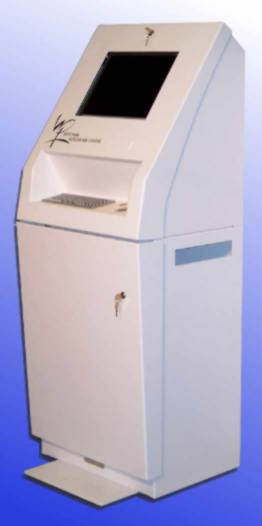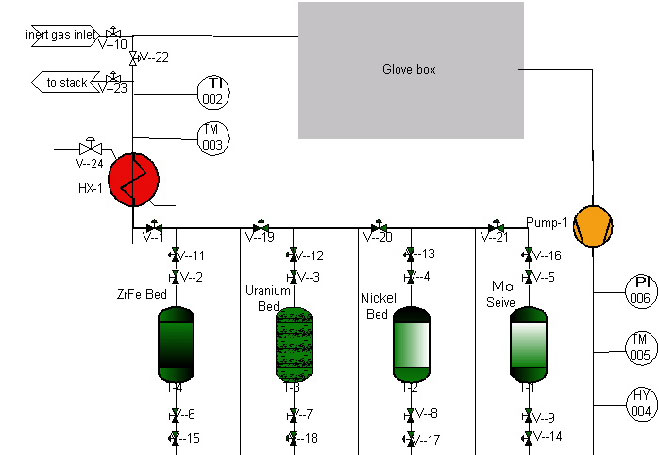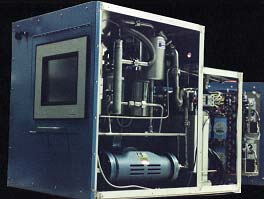Secondary Enclosure Clean-up System (SEC)
Model: 7013-SEC-001
Application
Tritium has the ability to permeate elastomers and metal walls, particularly when the walls are heated. It is for this reason that tritium systems are usually put inside secondary enclosures or glove boxes. Since it is likely that the glove box atmosphere will eventually become contaminated with tritium, an atmosphere clean-up system is often required. This clean up system is sometimes referred to as a Secondary Enclosure Clean-up System or SEC System. The clean-up system can also regulate temperature, humidity, and remove other impurities.
Features
-
Automatic operation
-
Glove box temperature & pressure control
-
Tritium monitoring, entrapment and reuse
-
Moisture control
-
Custom built stand alone system
-
Can be moved to other glove boxes

Description
The Secondary Enclosure Clean-up system (SEC) comprises a stand alone system which can be attached to any glove box, so one unit can service several boxes of a tritium facility. The SEC system has two main duties, firstly to assess the conditions of the glove box atmosphere and secondly to safely clean up or replace it.
The system circulates continuously on bed by-pass mode, and assessment of the inert atmosphere is done by measuring the gas stream for tritium, measuring humidity, temperature and pressure. The SEC system will assess whether to purge the box to atmosphere, replace it with clean inert gas, pass it though a bank of getter beds to first clean up the atmosphere, or leave it on bed by-pass mode.
The SEC system may contain a 5A molecular sieve bed to remove moisture, and a nickel bed to crack organics and absorb oxygen. One or more beds will be used for the removal of tritium, these will normally comprise a uranium bed and a ZrFe bed, but two ZrFe beds are better options for some circumstances.

Outline diagram of the circuit
The beds are located in a circuit with by-pass lines around them and suitable valving to permit any bed to be included or excluded.

Under bench unit with pull up touch screen computer for easy operation
Pneumatic valves are operated automatically through a computer control process. A high integrity diaphragm pump will circulate the atmosphere of the glove box, which will be monitored for temperature and if necessary cooled; will monitor for humidity, and if high humidity is indicated together with low tritium, the gas will be discharged to stack and replaced with fresh, dry, inert gas; if tritium is also indicated, the gas will be passed through a mol sieve bed to dry it removing HTO, and then through a getter bed to remove elemental tritium. Cooling, if required, is normally via chilled water in a tube-in-tube heat exchanger, or with a finned cooling system using an air blower. Variations and requirements will be discussed with each Client to best meet their needs.
Specifications
| Flow Rate | 2 l/s |
| Clean-up rate | 1 hr for 1m³ box (assumes 5 changes) |
| Computer Control System | Fully automatic with manual override from touch sensitive screen. |
| Uranium bed | Singly contained pressure vessel insulated, with heater and thermocouples, 250 grams (30,000 Ci) |
| Molecular sieve | Singly contained pressure vessel insulated, with heater and thermocouples, 5A, 1kg, |
| Tritium measurement sensitivity | 1µ/m³ on both inlet and outlet from the glove box. |
| Pressure control of glove box | +/-150 mm water gauge |
| Temperature control | Thermocouples and heat exchanger |
| Heat exchanger | Stainless inner tube for process flow, copper outer tube for cooling flow |
| Nickel bed | Singly contained pressure vessel insulated, with heater and thermocouples 250 grams |
| ZrFe bed | Singly contained pressure vessel insulated, with heater and thermocouples 500 grams |
| Humidity | +/-2°C between -65°C and 20°C |
| Kiosk Cabinet size | Height 1500 mm Width 600 mm Depth 500 mm Weight 150 kg |


